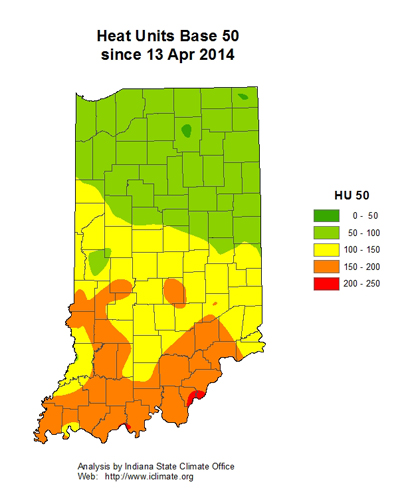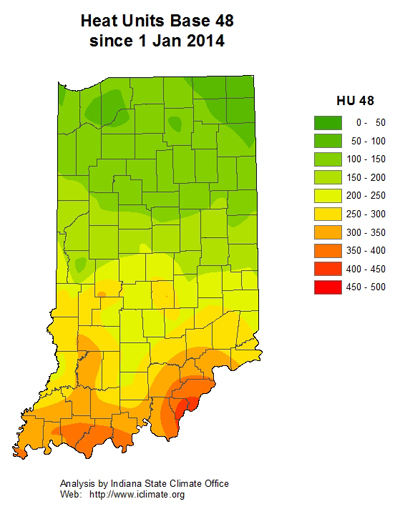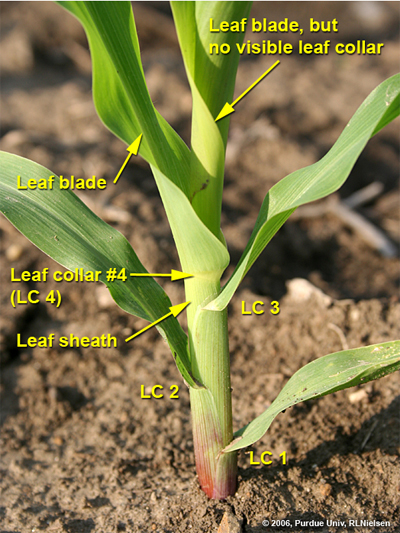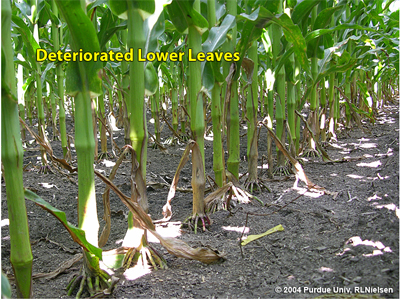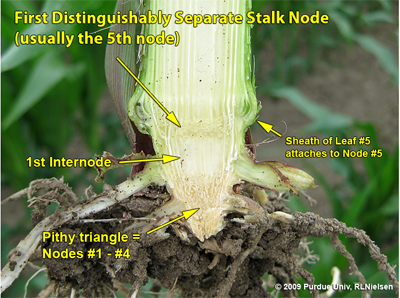USDA-NIFA Extension IPM Grant
Pest & Crop Newsletter, Entomology Extension, Purdue University
Black Cutworm Moths Just Keep Coming- (Christian Krupke and John Obermeyer)
• Arriving moths are looking for egg laying sites (e.g., weedy fields, fields with extensive ground cover, etc.), and there are many to choose from.
• Accumulations of approximately 300 heat units (base 50°F) needed after egg hatch before crop damage will be noted.
Black cutworm moth catches in pheromone traps throughout the state have been a mixed bag over the last week (see “Black Cutworm Adult Pheromone Trap Report”). With the recent weather fronts moving through the upper Midwest, trap catches increased dramatically in several areas over the past week. These types of catches signal that we may see some feeding activity this growing season. This will be especially true if producers’ fields received anticipated rain showers and weed control activities are delayed, as moth flights continue into the state.
Refer to the following map, where we are tracking black cutworm development from the time of an intensive capture to when we expect first cutting/damage. Based on the growth development model, it takes approximately 300 heat units (50?F base) from egg hatch to early 4th instar; this is the life stage when black cutworm larvae begin to cut plants. Some leaf injury may be present before then. Using pheromone trapping of moths and tracking of heat unit accumulations for first cutting is not an exact science, but they do give us a good indication of what to expect. It is not possible to predict if individual fields will be infested. Remember, based on past history, most fields in the state will see little or no activity. This is just not a pest that has done much damage statewide lately, although just a few fields are hit hard each year.
Cutworms can be managed very effectively through timely field monitoring to determine if and when a foliar insecticide is needed. “Insurance” treatments, i.e., seed treatments at planting, are seldom cost-effective, because cutworms are a very sporadic problem and most fields treated would not suffer any economic damage even if left untreated. Furthermore, these preventative treatments may not provide acceptable control of heavy infestations of cutworms, necessitating a rescue treatment. Happy Scouting!
Eric Anderson's Allen County, bountiful black cutworm catch
![]()
Bug Scout says: "Any corn up in Southern Indiana counties should be scouted for leaf feeding!"
![]()
Bug Scout says: "Scout for alfalfa weevil feeding damage in areas above 200+ accumulations
![]()
Click here to see the Armyworm Pheromone Trap Report
![]()
Black Cutworm Adult Pheromone Trap Report
![]()
Cold Temperatures & Injury to Newly Planted Corn – (Bob Nielsen) -
Corn planting progress throughout Indiana in 2014 has been slow to date. As of April 27, USDA-NASS estimated that 8% of Indiana’s corn crop had been planted, compared to an average of 26% for the past five years. The primary reasons for the slow start have been wet soil conditions and cool soil temperatures. Where soil moisture was acceptable for planting, some growers accepted (or ignored) the risks associated with cold soils and corn germination or initial seedling development and planted corn. Should they be concerned about the health of their newly planted and, in a few cases, newly emerged crops? Well, we’ll know for certain come harvest time. But in the mean time, we can talk about possibilities.
Newly Planted Corn
One of the risks that newly planted corn faces is that of imbibitional chilling injury due to cold soil temperatures during the initial 24 to 36 hours after seeding when the kernels imbibe water and begin the germination process. In response to the imbibition of water, kernels naturally swell or expand. If the cell tissues of the kernel are too cold, they become less elastic and may rupture during the swelling process. Some sources indicate that the injury is not so much due to literal cell membrane rupture, but rather to the failure of embryonic cell membranes to reorganize their structure from a dry and somewhat “leaky” state to a rehydrated and less permeable state during the initial period following imbibition. Regardless of the cause, the symptoms of imbibitional chilling injury include swollen kernels that swell but fail to exhibit further signs of germination or arrested growth of the radicle root and/or coleoptile following the initiation of the germination process.
It is not clear how low soil temperatures need to be for imbibitional chilling or subsequent chilling injury to occur. Some sources simply implicate temperatures less than 50°F (10C). Others suggest the threshold soil temperature is 41°F (5C). Daily minimum soil temperatures at the 4-inch depth (typical depth for National Weather Service measurements) have been in the mid- to high 40’s°F around the state in the past week or so, especially in the northern third of the state. Elsewhere, daily minimum soil temperatures have ranged from the low 50’s to the low 60’s; probably warm enough NOT to cause imbibitional chilling injury to corn.
Instances of non-imbibitional chilling injury following germination during the emergence process can also occur, often causing stunting or death of the seminal root system, deformed elongation of the mesocotyl (the so-called “corkscrew” symptom) and either delayed emergence or complete failure of emergence (i.e., leafing out underground). This type of chilling injury is more closely related to physical damage to the outer cell tissues that literally cause death of the plant part or inhibit further elongation of the affected area. Thus, chilling injury to only part of the circumference of the mesocotyl results in the “corkscrew” symptom as the undamaged sections of the mesocotyl continue to elongate.
Newly Emerged Corn
Damage from exposure of above-ground plant tissue to frost can range from minor leaf injury to complete death of all exposed leaf tissue. That’s the bad news. The good news is that the all-important growing point region of a young corn plant remains below the soil surface, safe from exposure to frost, until the V4 to V6 stages of development. That means that the above-ground plant tissue you see in fields younger than about V4 is composed primarily of leaves and rolled up leaf tissue in the whorl, but does not include stalk tissue or the growing point. As long as temperatures are not lethally cold, “simple” frost injury usually does not literally kill such young corn plants. Damaged plants will begin to show recovery from the whorl within 5 to 7 days, depending on temperatures following the frost event.
Disclaimer: Repeated frost events that re-inflict damage to recovering corn plants can cause permanent stunting or death.
When folks worry about the effects of cold weather on corn, they often fail to distinguish between simple frost events and lethal cold temperatures. Frost can occur at temperatures easily up to the high 30’s°F, but lethal cold temperatures for corn are generally thought to be 28°F (-2C) or colder. With little to none of the 2014 corn crop emerged to date plus the near absence of such low temperatures in the past week or so, I doubt that any above-ground injury to “early” planted corn has yet occurred.
Bottom Line
Only time will tell whether corn planted during the past couple of weeks has suffered from the cool soils during germination. Obviously, those “early” planted fields should be scouted over the next few weeks for emergence problems. Come October, we will know for certain whether this year’s early planting risk takers will have “won the game” or not.
Related Reading
Kruger, Greg, Jim Specht, Roger Elmore, Jenny Rees, and Tom Hoegemeyer. 2014. Factors Influencing Cold Stress in Corn and Soybean. CropWatch, Univ of Nebraska Extension. <http://goo.gl/Ya0owU> [URL accessed Apr 2014].
Nielsen, RL (Bob). 2001. Symptoms of Low Temperature Injury to Corn and Soybean. Corny News Network, Purdue Univ. <http://www.kingcorn.org/news/articles.01/Frost_Corn_Soy-0418_Gallery.html> [URL accessed Apr 2014].
Nielsen, RL (Bob). 2008. Growing Points of Interest. Corny News Network, Purdue Univ. <http://www.kingcorn.org/news/timeless/GrowingPoints.html> [URL accessed Apr 2014].
Nielsen, RL (Bob). 2010. Germination Events in Corn. Corny News Network, Purdue Univ. <http://www.kingcorn.org/news/timeless/GerminationEvents.html> [URL accessed Apr 2014].
Nielsen, RL (Bob). 2010. Requirements for Uniform Germination & Emergence of Corn. Corny News Network, Purdue Univ. <http://www.kingcorn.org/news/timeless/GermEmergReq.html> [URL accessed Apr 2014].
Nielsen, RL (Bob). 2010. The Emergence Process in Corn. Corny News Network, Purdue Univ. <http://www.kingcorn.org/news/timeless/Emergence.html> [URL accessed Apr 2014].
Nielsen, RL (Bob). 2012. Corkscrewed Corn Seedlings.Corny News Network, Purdue Univ. <http://www.kingcorn.org/news/articles/timeless/Corkscrews.html> [URL accessed Apr 2014].
Nielsen, RL (Bob). 2014. Determining Corn Leaf Stages. Corny News Network, Purdue Univ. <http://www.kingcorn.org/news/timeless/VStageMethods.html> [URL accessed Apr 2014].
![]()
Determining Corn Leaf Stages – (Bob Nielsen) -
Many of us remember standing against the doorframe in our early years while our parents marked our height with a pencil to measure how much we had grown. Some of you may have spent more time in your youth standing in the corner, but that is between you and your parents.
Because it is difficult to transport corn plants from the field to that doorframe to measure their growth, agronomists developed other means to measure the phenology or development of corn. Counting the number of leaves would seem to be a simple way to document corn development, but folks still tend to become confused over this simple strategy. There are two basic methods for leaf staging corn in use today.
Leaf Collar Method. This method determines leaf stage in corn by counting the number of leaves on a plant with visible leaf collars, beginning with the lowermost, short, rounded-tip true leaf and ending with the uppermost leaf with a visible leaf collar (Abendroth et. al., 2011). The leaf collar is the light-colored collar-like “band” located at the base of an exposed leaf blade, near the spot where the leaf blade comes in contact with the stem of the plant.
The lowermost, thumb-shaped leaf of a corn plant
Parts of a corn leaf
Leaves within the whorl, not yet fully expanded and with no visible leaf collar are not included in this leaf staging method. The exception to this statement may be that leaves with barely visible leaf collars can be counted when you are staging plants early in the day, recognizing that the leaf collar may become completely visible by the end of the day.
Leaf stages are usually described as “V” stages, e.g., V2 = two leaves with visible leaf collars. The leaf collar method is generally the most widely used method by university and industry agronomists in the U.S.
TIP: Recognize that not all plants in a given field will be at the same leaf stage at the same time due to normal variability among plants for emergence or subsequent exposure to stress. By definition, the specific leaf stage for an entire field is defined by that value that represents the majority of the plants in the field (Abendroth et. al., 2011). For example, if half or more of the plants you rate are at the V5 stage of development, then the entire field is assigned a V5 rating.
“Droopy” Leaf Method. Crop insurance adjusters, when assessing damage to a corn crop from weather events such as hailstorms, use this leaf staging method. Like the leaf collar method, this method of leaf staging begins with the short first leaf. Leaf counting then differs, though, by ending not with the uppermost leaf with a visible collar, but at that leaf that is at least 40 to 50 percent exposed from the whorl. In knee-high corn or older, the tip of this “indicator” leaf typically also “droops” or hangs down, hence the name “droopy” leaf method.
Young corn plant staged as V3 according to the collar method
Same plant, but staged as 4-leaf according to the “droopy” method
The Two Methods Compared. Both methods assign a leaf stage to a field on the basis of the leaf stage common to the majority of the plants in the field. Up to the 5- or 6-leaf collar stage, the leaf collar method will typically result in a leaf stage value that is one less than the “droopy” leaf method. After corn reaches 18 to 24 inches in height, the leaf collar method will typically result in a leaf stage value that is two less than the “droopy” leaf method.
The usefulness in understanding the differences between these two leaf staging methods lies in the fact that the defoliation/yield loss chart used by hail insurance adjusters is based on the “droopy” leaf method. That chart is reproduced in the Purdue Extension publication ID-179, Corn & Soybean Field Guide. Identifying true “droopy” leaves on shredded, hail-damaged corn plants can be quite difficult, whereas leaf collars are often still identifiable. Thus, you can usually stage a damaged crop by the leaf collar method and then add one or two more leaves to the count in order to use the defoliation chart.
What About Herbicide Labels? Growers’ confusion with leaf staging often originates with less than clearly described growth stage restrictions listed on herbicide labels (Loux et. al., 2014). Label restrictions of older post-emergence herbicides typically ignored the short first leaf with the rounded tip and ended with the uppermost leaf that was at least 50% exposed from whorl. In essence, this was a bastardized “droopy leaf” method that resulted in roughly the same numerical leaf stage as the leaf collar method. Newer labels purport to define leaf stages according to the leaf collar method, but there is still some question about whether the short first leaf with the rounded tip is included. If in doubt with these newer herbicides, check with your agricultural chemical technical representative to verify which leaf staging method is appropriate for the herbicide you intend to use.
Staging Older Plants. As corn plants develop, the lower few leaves typically die or are torn away from the stem by the expansion of the stalk or by developing roots. Consequently, growth stage identification can be difficult on older plants when you aren’t sure which leaves to begin counting first. But, not to worry, growth staging can still be accomplished!
Typical deterioriation of lower leaves in older corn plants
Split stalk illustrating the first distinguishable node above the pithy triangle
First, dig or pull a plant without breaking the stalk. With a knife, carefully split the stalk down the middle, completely through the root ball. Look for the lowermost obvious internode (the whitish area between the “woody” horizontal stalk nodes) above the triangular “woody” base of the stalk. The length of this first internode is typically only 1/2 to 3/4 inch (1.3 to 1.9 cm for you fans of the metric system).
Determine which leaf corresponds with the node immediately above the first noticeable internode by carefully identifying which leaf sheath attaches to the node. This leaf is usually Leaf #5. Once Leaf #5 is identified, then stage the plant by continuing to count the remainder of the leaves with visible leaf collars above Leaf #5. For example, assume you’ve identified Leaf #5 and there are six more leaves above that one with visible leaf collars, then the plant is at leaf stage V11 (11 leaves with visible leaf collars).
Useful Tip: Even though one or more lower leaves may have “disappeared” due to injury or natural senescence, their absence does not mean they should be forgotten or ignored. In other words, a plant that is assessed at being at the V12 stage as a result of the previously described stalk splitting steps may only have 8 leaves with visible leaf collars if 4 lower ones have already withered away. Do not be misled into thinking the plant is only at the V8 stage.
Related References
Abendroth, L.J., R.W Elmore, M.J. Boyer, and S.K. Marlay. 2011. Corn Growth and Development. Iowa State Univ. Extension Publication #PMR-1009. <https://store.extension.iastate.edu/Product/Corn-Growth-and-Development> [URL accessed Apr 2014].
Loux, Mark, Doug Doohan, Anthony F. Dobbels, Bill Johnson, and Travis Legleiter. 2014. 2010 Weed Control Guide for Ohio and Indiana (WS-16). Table 6: Rainfast Intervals, Spray Additives, and Maximum Crop Size for Postemergence Corn Herbicides. Purdue Univ. & Ohio State Univ. Coop. Ext. Services. <http://www.btny.purdue.edu/Pubs/WS/WS-16> [URL accessed Apr 2014]
.
Nielsen, R.L. (Bob). 2008. Tips for Staging Corn with Severe Leaf Damage. Corny News Network, Purdue Univ. [On-Line]. Available at <http://www.kingcorn.org/news/timeless/VStagingTips.html> [URL accessed Apr 2014].
Nielsen, R.L. (Bob). 2008. Use Thermal Time to Predict Leaf Stage Development in Corn. Corny News Network, Purdue Univ. [On-Line]. Available at <http://www.kingcorn.org/news/timeless/VStagePrediction.html> [URL accessed Apr 2014].
Nielsen, R.L. (Bob). 2012. Heat Unit Concepts Related to Corn Development. Corny News Network, Purdue Univ. [On-Line]. Available at <http://www.kingcorn.org/news/timeless/HeatUnits.html> [URL accessed Apr 2014].
Purdue University. 2010. Corn & Soybean Field Guide (ID-179). To order, call Purdue Extension toll-free at (888) 398-4636 and ask for the Media Distribution Center.
![]()
Use Thermal Time to Predict Leaf Stage Development in Corn – (Bob Nielsen) -
Being able to predict when a field of corn will reach particular leaf stages can be useful for scheduling post-emergence applications of certain herbicides and sidedress N fertilizer, especially if your farming operation is so large that regular field inspections are difficult to work into your busy schedule. Leaf stage can be predicted on the basis of heat unit accumulation (aka growing degree days) from planting to the date in question.
Review of Concepts. For a refresher on how corn leaf staging is done, read my article “Determining Corn Leaf Stages” (Nielsen, 2014). Another topic that probably needs reviewing is the concept of heat units (HUs) or growing degree days (GDDs). The concept is important because corn phenology is very dependent on temperature. Heat unit or GDD calculation for corn phenology is described in another accompanying article “Heat Unit Concepts Related to Corn Development (Nielsen, 2012).
Useful Tip: A new online tool is available that provides real-time estimates plus future projections of GDD accumulations on a county-level basis. The “Corn Growing Degree Day Tool” is available at <https://drinet.hubzero.org/groups/u2u/tools/gdd> and was developed as part of a USDA-funded research and Extension project titled “Useful to Usable”.
Predicting Corn Phenology. Given an understanding of corn leaf stage development and heat unit calculation, you can predict the leaf stage of development for a particular field given its planting date and temperatures since planting. It is useful if you know when the crop emerged, but if not you can estimate that event also. Corn emergence typically requires from 100 to 120 GDDs from planting.
We know from previous research that corn leaf development rates can be accurately described by separate linear response curves for early and late vegetative development (Wuethrich, 1997). From emergence to leaf stage V10 (ten visible leaf collars), leaf collar emergence occurs at about one leaf every 82 GDDs (Wuethrich’s data suggested 85 GDDs, but 11 years of plot data since suggests closer to 82 GDDs). From leaf stage V10 to the final leaf, leaf collar emergence occurs more rapidly at approximately one leaf every 50 GDDs.
Useful Tip: From planting to about V6, plant development, including time to emergence, responds more closely to soil temperatures than to air temperatures. This time frame corresponds to that when the main growing point (apical meristem) of the corn plant is positioned below the soil surface. Rapid elongation of stalk internodes after V6 elevates the growing point above ground. From that point forward, plant development is affected more directly by air temperature. Consequently, leaf stage prediction up to about V6 is more reliable if soil temperatures are used to calculate daily GDDs. After V6, air temperatures are the more predictive basis for GDD calculations.
Example 1: A field was planted on April 28 and emerged on May 5. Since May 5, approximately 535 GDDs have accumulated. Based on our research data, the estimated leaf stage for the crop (without looking at the field, mind you) would be between V6 and V7 (6 leaves x 82 GDDs = 492 GDDs; 7 leaves x 82 GDDs = 574 GDDs).
Example 2: A field was planted on April 28, but you do not know exactly when it emerged. Since planting, approximately 785 GDDs have accumulated. If you assume that the crop emerged in about 120 GDDs, then the estimated leaf stage for the crop would be about V8. This estimate is calculated by first subtracting 120 from 785 to account for the estimated thermal time to emergence, then dividing the result (665) by 82 (equal to 8.1).
Example 3: A field was planted on April 28 and emerged on May 5. Since May 5, approximately 1220 GDDs have accumulated. Your familiarity with these calculations tells you that the crop is likely beyond V10 (equal to 10 x 82 or 820 GDDs since emergence). So, first subtract 820 from 1220 (knowing the crop is at least at V10). Divide the result (400) by 50 to equal 8 additional leaves; for a total estimated leaf stage of V18.
Keep in mind that estimates of leaf stage development are only that, estimates. One of the factors that most influences the accuracy of these estimates is the existence or not of other growth-limiting stresses. Severe plant stress will generally retard stem and leaf sheath elongation, thus delaying the appearance of leaf collars. However, what I have described here will put you in the proverbial ballpark in determining which fields are at which leaf stages on a given day.
Related References
Loux, Mark, Doug Doohan, Anthony F. Dobbels, Bill Johnson, and Travis Legleiter. 2014. 2010 Weed Control Guide for Ohio and Indiana (WS-16). Table 6: Rainfast Intervals, Spray Additives, and Maximum Crop Size for Postemergence Corn Herbicides. Purdue Univ. & Ohio State Univ. Coop. Ext. Services. <http://www.btny.purdue.edu/Pubs/WS/WS-16> [URL accessed Apr 2014].
Nielsen, R.L. (Bob). 2008. Tips for Staging Corn with Severe Leaf Damage. Corny News Network, Purdue Univ. <http://www.kingcorn.org/news/timeless/VStagingTips.html> (URL accessedApr 2014).
Nielsen, R.L. (Bob). 2012. Heat Unit Concepts Related to Corn Development. Corny News Network, Purdue Univ. <http://www.kingcorn.org/news/timeless/HeatUnits.html> (URL accessed Apr 2014).
Nielsen, R.L. (Bob). 2014. Determining Corn Leaf Stages. [On-Line]. Corny News Network, Purdue Univ. <http://www.kingcorn.org/news/timeless/VStageMethods.html> (URL accessed Apr 2014).
Purdue University. 2014. Corn & Soybean Field Guide (ID-179). <https://ag.purdue.edu/agry/dtc/Pages/CSFG.aspx> [URL accessed Apr 2014]
Wuethrich, Kirby. 1997. Vegetative and Reproductive Phenology of Fourteen Hybrids of Dent Corn (Zea mays L.). M.S. thesis, Purdue Univ.
![]()


